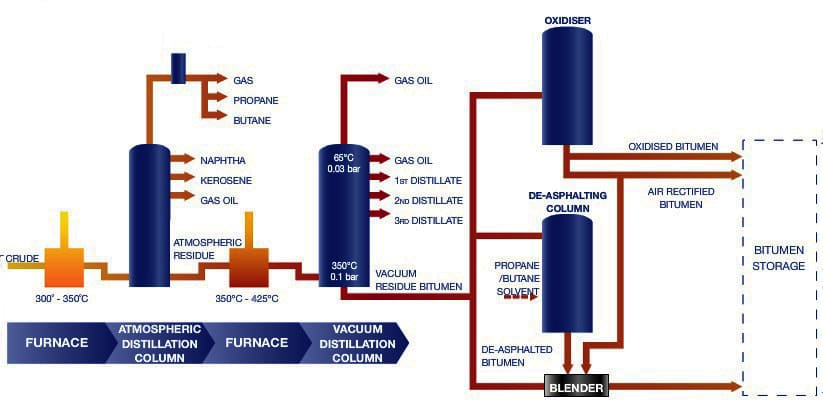Only a small number of crude oils are suitable for producing bitumen in commercial quantities of the required quality. In general, these are heavy crude oils with high Sulphur content.
Nowadays, it is common practice to blend multiple crude oils to produce consistent quality bitumen that meets exacting technical specifications in modern integrated refineries.
Production Process
In order to produce bitumen, crude oils have to be refined to produce the raw materials. Separating the lighter fractions and residues from bitumen refinement. Specification bitumen can be produced using a variety of processes depending on the source of crude oil and the processing capabilities available. Processes may be combined in some cases. Below you will find a visual representation of the methods used in refineries.
Nowadays, it is common practice to blend multiple crude oils to produce consistent quality bitumen that meets exacting technical specifications in modern integrated refineries.


- Distillation
As part of this process, crude oil is heated to temperatures between 300 and 350 degrees Celsius, in order to separate lighter fractions from a non-boiling component called an atmospheric residue. Lighter fractions are separated and sent to other refinery units. To remove the last traces of the lighter fractions and to prevent the thermal transformation of the molecules, the atmospheric residue is then introduced into a vacuum distillation unit, where the pressure reduction lowers boiling temperatures and prevents unwanted thermal cracking of the molecules. The pressure and temperature conditions within the vacuum process determine the hardness of the residue, as well as the grade of bitumen produced. The lubricant and bitumen components of crude can also be separated using specific solvents without changing their chemical structure.
Different categories of bitumen can be obtained based on the solvent used – propane or butane. Vacuum distillation can be used to produce bitumen with varying degrees of hardness by controlling the variables. Bitumen manufactured to engineering specifications has two fundamental characteristics, needle penetration, and softening point. The physical properties of bitumen can be altered by blowing air through it at elevated temperatures.
There are two types of bitumen produced in this way, depending on the degree of oxidation: air rectified bitumen and oxidized bitumen. Oxidized bitumen is used for roofs, while air rectified bitumen is used for paving and some roofing. Oxidized bitumen has a distinctive consistency at room temperature and a rubbery nature that alters its response to stress. Oxidation increases the stiffness and softening point Ring and Ball of bitumen and notably alters its physical properties. The duration of the oxidation or air blowing process alters the extent of the reaction and produces distinctive end products.
- Solvent de-asphalting
- Oxidation
By blowing air through it at elevated temperatures, straight-run bitumen can be further processed to alter its physical properties. As a result, air-rectified bitumen and oxidized bitumen are produced as a result of oxidation.
- Air-rectified bitumen is mildly blown and similar to straight run bitumen.
- Oxidized bitumen is used in roofing applications: they have a distinctive consistency at room temperature and a rubbery nature that affects how they respond to stress – such as can be caused by large temperature changes as found on rooftops.
Oxidation alters the physical properties of the material by raising the softening point and increasing the stiffness. Oxidation or air blowing processes vary in length and cause the reaction to occur at a different pace, resulting in distinct end products.
The blending of higher and lower viscosity residues in the required proportions can be performed at the refinery, at terminals, or at a third-party facility, from where finished products can be distributed. Various processing techniques can produce different grades of bitumen.
- Blending
As a result of the refining process or through blending bitumen with a range of physical properties, the final bitumen product can be refined to several technical specifications. Blend components and finished products can be easily transported and distributed when they are produced at the refinery, at terminals, or at third-party facilities that blend elements with varying viscosities in the right proportions.
Each processing technique results in different grades of bitumen products, including:
- Hard grade bitumen – used for paving.
- Cutback bitumen – blends of penetration bitumens with a solvent such as kerosene.
- Emulsions – stabilized suspensions of bitumen in water.
- Polymer modified bitumen – mixtures of selected bitumen with polymers, such as thermoplastics or elastomers.
